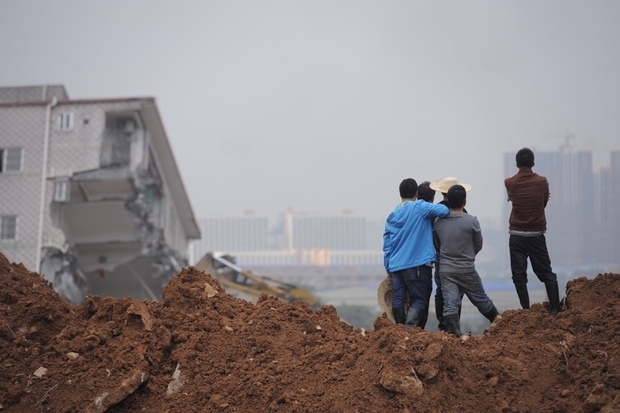On December 20, a tidal wave of red dirt and construction waste descended on Guangming New District, part of the Chinese southern megacity of Shenzhen, burying whole buildings and sending residents scrambling in fright. Those facts, captured in unforgettable video by smartphone-wielding residents, are beyond dispute, and Chinese authorities say that one person has been found dead, with 76 currently still listed as missing.
But whether that event is a “natural disaster,” a “landslide,” or something else has quickly become a point of contention in a country that in 2015 has seen several spectacular tragedies, some the result of lax regulation and preventable human error. State media reports overwhelmingly label what happened in Shenzhen a “landslide.” But some on Chinese social media are complaining that the term elides human culpability in ignoring warnings as the debris piled ever higher, joining a string of high-profile incidents that some Chinese view as a collective indictment of poor governance that prioritizes economic growth over human safety.
Hours after the incident, the debate on terminology was poised to go mainstream. On the microblogging platform Weibo, the news portal Sina asked its readers directly: “Is this a natural disaster or a man-made disaster?” It noted that “preliminary investigations show it was a man-made pile that collapsed, not a slide in the original mountain” underlying it. (Reporting from The New York Times indicates that some locals knew of the growing risk for some time.) Sina’s query attracted over 4,000 comments. One of the most popular lamented how people “had built their own mountain to bury themselves—poor Chinese.” Another expressed gratitude that it hadn’t rained the day of the disaster, lest “God be blamed.” But by December 22, the discussion had been deleted, a frequent fate for sensitive posts on China’s tightly controlled web.
But the issue remains a sore spot. Web commenters jumped on a subsequent Sina news post that declared the incident a “mudslide.” Responses insisted that the 20-story mound, which sat precariously above a population center in Guangming, was an “artificial dirt pile” and a “man-made mountain.” Another implored state media not to “tarnish the term ‘landslide.’”
One widely followed blogger, author Xu Fengwen, put the disaster in grim context, writing on Weibo that the waning hours of 2014 saw a horrific new year’s stampede in Shanghai that killed 36, followed by the June 1 sinking of the Oriental Star in the Yangtze River that killed over 400, and then the August 12 explosion of a chemical storehouse in the northeastern city of Tianjin that killed 173. To some Chinese observers, these tragedies are the government’s fault; in Shanghai, police had not prepared to handle the number of revelers, while the ferry sinking and Tianjin blast traced back to insufficient regulation. “This year,” wrote Xu, “has been unforgettable.”
The Tianjin explosion carries particular parallels with what happened in Shenzhen. In both cases, dangerous activities in or very near to residential areas led to spectacular tragedy, news of which was rapidly caught and disseminated via smartphone. In the aftermaths of both, President Xi Jinping was quick to declare an “all out” effort to save those injured or trapped, and state media released a drumbeat of updates around heroic rescue operations.
But the discussion of the Tianjin explosion ultimately faded from the headlines, and Shenzhen’s disaster is sure to follow suit. The topic has already fallen out of the top trending terms on major social media platforms like Weibo and mobile-based Weixin. It’s hard to know whether these topics declined naturally or were forced from prominence, but that may not matter. The long, complex process of determining culpability and compensating victims is likely to be carried out behind a thick veil, or not at all. For example, when Tianjin residents impacted by the August chemical blast were reportedly pressured to accept below-market payouts, state and social media stayed mum. “Every time” a disaster strikes, “we light a candle, pray, get emotional,” one commenter lamented. “And then it disappears, like clouds scattering.”
Bethany Allen-Ebrahimian contributed research.




